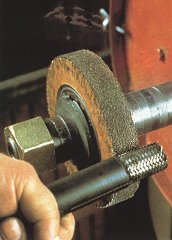Stripping

During stripping , part of the insulating sleeve, also called insulation or insulation, of an electrical conductor ( wire or stranded wire ) is removed over a certain length required for connection.
The length to be stripped results from the dimensions of the terminal point to which the wire is to be connected, or from the length of the end sleeve with which the stranded wires are fitted.
The insulating sleeve is removed with a special tool, a wire stripper or a wire stripping knife . Brushes arranged in opposite directions are also used for stripping in automatic production processes . These usually have a corrugated steel wire that is embedded in an elastic plastic compound. Further methods are stripping with a laser beam , which is used in automatic production facilities. Furthermore, there are automatic cutting and stripping machines in the industrial environment that cut a cable to a certain length and perform the stripping at the same time.
In order to avoid unwanted breaks, the conductor must not be damaged by notches when stripping the insulation. The limit value for reducing the cable cross-section is 5%.
Stripping pliers are usually used in a craft environment or for manual processing. If the quality requirements are low, a cable knife or a tool that is not designed for this, such as a side cutter , can be used, but this can easily damage the conductor.
Dismantling
In a broader sense, stripping also includes the previous stripping, i.e. the removal of the jacket, which includes all the individual cables again. For this purpose, the outer sheath is first cut open in a ring shape with the stripper , a special tool, then cut open along the longitudinal axis of the cable and then pulled off the cable.
literature
- Hans-Günter Boy, Uwe Dunkhase: Electrical installation technology - the master's examination . 12th edition, Vogel Buchverlag, Oldenburg and Würzburg, 2007, ISBN 978-3-8343-3079-6
